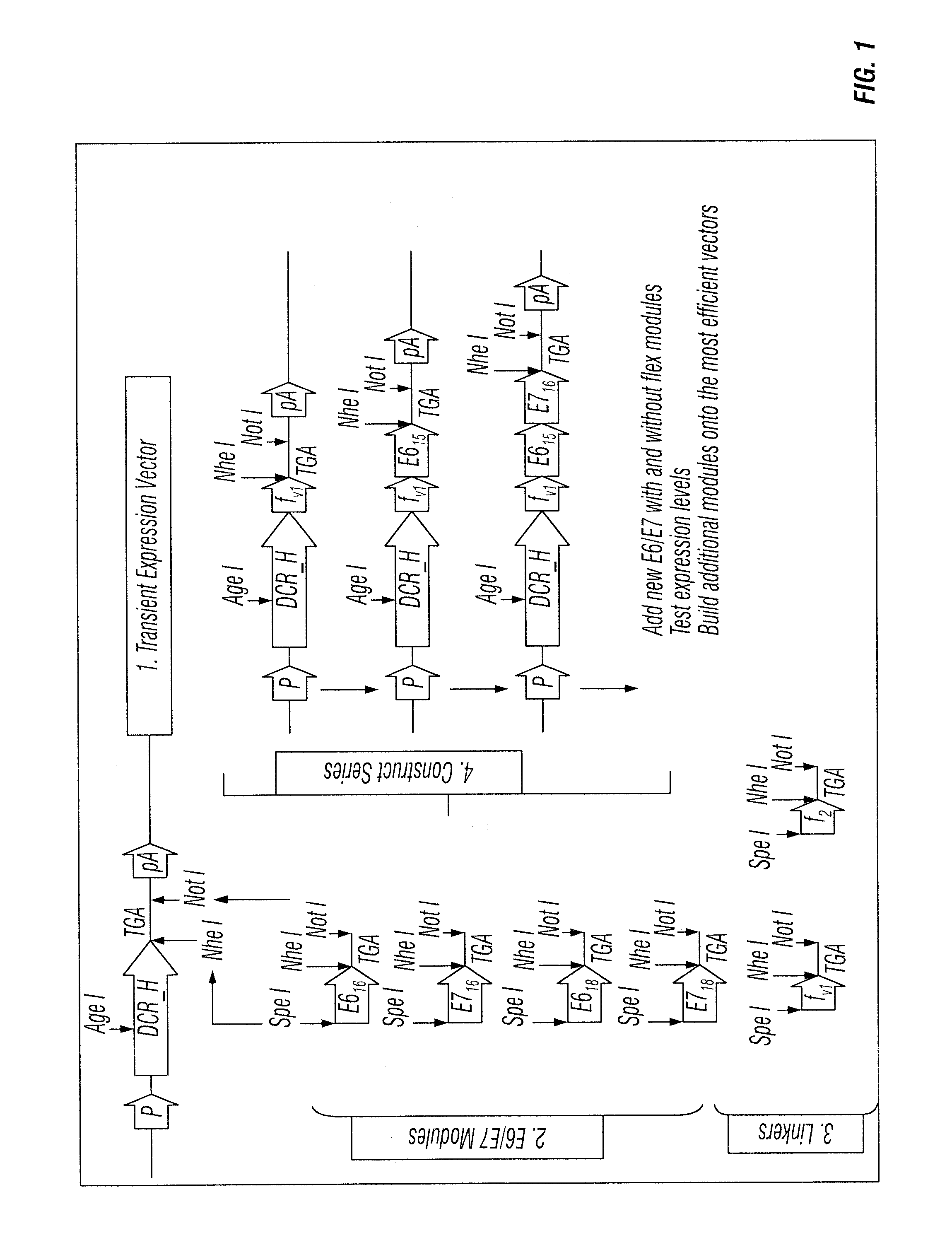Novel vaccines against HPV and HPV-related diseases
a technology of human papilloma virus and vaccines, applied in the field of medicine, can solve the problems of ineffective treatment of infected patients and hpv-related cancers, vaccines have drawbacks in efficacy or safety, especially in immunodeficient patients, and achieve the effects of reducing tumor size or mass, improving patient quality of life, and easing discomfor
- Summary
- Abstract
- Description
- Claims
- Application Information
AI Technical Summary
Benefits of technology
Problems solved by technology
Method used
Image
Examples
example 1
Recombinant Fusion Proteins of Anti-DC Receptors (DCRs) and HPV E6 and E6 Fusion Proteins
[0150]The inventors' scheme for the development of expression constructs for production of anti-DC receptor antibodies fused to E6 and E7 sequences from HPV 16 and 18 is given in FIG. 1. The scheme identifies an order of antigen cassettes encoding E6 and E7 from HPV 16 and 18 that is efficiently secreted and are intact when fused to the H chain C-terminus. There are 64 possible combinations of just these 4 sequences, and very many more when interspersed with flexible linker sequences. The inventors' strategy is a stepwise approach starting with each antigen alone, with and without a preceding flexible linker [8 initial constructs], then selecting those vectors that express most efficiently for adding on additional cassettes. Each cycle of construction and testing takes one week. Establishing the final production CHO-S cell lines take a further 8 weeks, including scale-up to levels suitable for v...
example 2
Recombinant Fusion Proteins of Anti-DC Receptors (DCRs), TLR Ligands, and HPV Sequences
[0159]Below is an example of a TLR2 ligand (tri-acylated cohesin, expressed in E. coli) where the C residue in the D1 leader domain is lipidated, this can be non-covalently attached to anti-CD40-HPV vaccine when the anti-CD40 has, e.g., a Dockerin domain fused to either the C-terminus or the L chain or the H chain C-terminus distal to the HPV E6 / 7 sequences.
D1-6His-Cohesin-Nhe-Spe-Not(SEQ ID NO: 23)MKKLLIAAMMAAALAACSQEAKQEVKEAVQAVESDVKDTAMGSSHHHHHHSSGLVPRGSHMASMDLDAVRIKVDTVNAKPGDTVNIPVRFSGIPSKGIANCDFVYSYDPNVLEIIEIKPGELIVDPNPTKSFDTAVYPDRKMIVFLFAEDSGTGAYAITKDGVFATIVAKVKEGAPNGLSVIKFVEVGGFANNDLVEQKTQFFDGGVNVGDTTEPATPTTPVTTPTTTDDLDAASLIKTSEF(note that additional cancer antigen sequencescan be added distal to the Cohesin domain)D1-6His-Cohesin-Nhe-Spe-Not DNA sequence(SEQ ID NO: 24)ATGAAAAAACTGCTGATTGCCGCCATGATGGCTGCAGCTCTGGCCGCATGCAGCCAGGAAGCCAAACAGGAAGTGAAAGAAGCCGTGCAGGCCGTGGAAAGCGATGTGAAAGATACCGCCATG...
example 3
CD40 Targeting HPV Vaccine (CD40HVac)
[0162]CD40HVac plus poly IC induces E6 / 7-specific CD8+ CTLs in human CD40 transgenic B6 (hCD40Tg) mice. hCD40Tg and WT animals (5 mice / group) were immunized subcutaneously (SC) with 30 μg CD40HVac plus 50 μg poly IC in PBS (100 μl) and boosted twice two weeks apart. The amounts of CD40HVac and poly IC were predetermined in separate experiments. Seven days after the second boosting, IFNγ ELISPOT was performed using purified CD8+ T cells from spleens (FIG. 8a). Compared to WT mice, hCD40Tg mice elicited increased numbers of CD8+IFNγ+ T cells. The inventors also observed that hCD40Tg mice had increased E7-specific CD8+ T cells in the blood, as measured by tetramer staining (FIG. 8b). In addition, CD40HVac plus poly IC induced greater levels of E6 / 7-specific CD4+ T cell responses in hCD40Tg mice than in WT animals (not shown). Taken together, the inventors concluded that CD40HVac targets human CD40 in vivo and can thus elicit E6 / 7-specific cellular r...
PUM
| Property | Measurement | Unit |
|---|---|---|
| size | aaaaa | aaaaa |
| volume | aaaaa | aaaaa |
| flexible | aaaaa | aaaaa |
Abstract
Description
Claims
Application Information
 Login to View More
Login to View More - R&D
- Intellectual Property
- Life Sciences
- Materials
- Tech Scout
- Unparalleled Data Quality
- Higher Quality Content
- 60% Fewer Hallucinations
Browse by: Latest US Patents, China's latest patents, Technical Efficacy Thesaurus, Application Domain, Technology Topic, Popular Technical Reports.
© 2025 PatSnap. All rights reserved.Legal|Privacy policy|Modern Slavery Act Transparency Statement|Sitemap|About US| Contact US: help@patsnap.com



